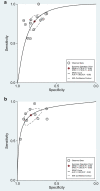Predictive values of neutrophil-to-lymphocyte ratio on disease severity and mortality in COVID-19 patients: a systematic review and meta-analysis
- PMID: 33198786
- PMCID: PMC7667659
- DOI: 10.1186/s13054-020-03374-8
Predictive values of neutrophil-to-lymphocyte ratio on disease severity and mortality in COVID-19 patients: a systematic review and meta-analysis
Abstract
Background: Coronavirus disease 2019 (COVID-19), a highly infectious disease, has been rapidly spreading all over the world and remains a great threat to global public health. Patients diagnosed with severe or critical cases have a poor prognosis. Hence, it is crucial for us to identify potentially severe or critical cases early and give timely treatments for targeted patients. In the clinical practice of treating patients with COVID-19, we have observed that the neutrophil-to-lymphocyte ratio (NLR) of severe patients is higher than that in mild patients. We performed this systematic review and meta-analysis to evaluate the predictive values of NLR on disease severity and mortality in patients with COVID-19.
Methods: We searched PubMed, EMBASE, China National Knowledge Infrastructure (CNKI) and Wanfang databases to identify eligible studies (up to August 11, 2020). Two authors independently screened studies and extracted data. The methodological quality of the included studies was assessed by Quality Assessment of Diagnostic Accuracy Studies 2 (QUADAS-2).
Results: Thirteen studies involving 1579 patients reported the predictive value of NLR on disease severity. The pooled sensitivity (SEN), specificity (SPE) and area under curve (AUC) were 0.78 (95% CI 0.70-0.84), 0.78 (95% CI 0.73-0.83) and 0.85 (95% CI 0.81-0.88), respectively. Ten studies involving 2967 patients reported the predictive value of NLR on mortality. The pooled SEN, SPE and AUC were 0.83 (95% CI 0.75-0.89), 0.83 (95% CI 0.74-0.89) and 0.90 (95% CI 0.87-0.92), respectively.
Conclusions: NLR has good predictive values on disease severity and mortality in patients with COVID-19 infection. Evaluating NLR can help clinicians identify potentially severe cases early, conduct early triage and initiate effective management in time, which may reduce the overall mortality of COVID-19.
Trial registry: This meta-analysis was prospectively registered on PROSPERO database (Registration number: CRD42020203612).
Keywords: Disease severity; Meta-analysis; Mortality; Neutrophil-to-lymphocyte ratio; Predictive; Systematic review.
Conflict of interest statement
The authors declare that they have no competing interests.
Figures




Similar articles
-
Ratios of neutrophil-to-lymphocyte and platelet-to-lymphocyte predict all-cause mortality in inpatients with coronavirus disease 2019 (COVID-19): a retrospective cohort study in a single medical centre.Epidemiol Infect. 2020 Sep 9;148:e211. doi: 10.1017/S0950268820002071. Epidemiol Infect. 2020. PMID: 32900409 Free PMC article.
-
Neutrophil-to-lymphocyte ratio predicts critical illness patients with 2019 coronavirus disease in the early stage.J Transl Med. 2020 May 20;18(1):206. doi: 10.1186/s12967-020-02374-0. J Transl Med. 2020. PMID: 32434518 Free PMC article.
-
Does Neutrophil-to-lymphocyte Ratio at Admission Predict Severity and Mortality in COVID-19 Patients? A Systematic Review and Meta-analysis.Indian J Crit Care Med. 2022 Mar;26(3):361-375. doi: 10.5005/jp-journals-10071-24135. Indian J Crit Care Med. 2022. PMID: 35519918 Free PMC article.
-
Rationale Use of Neutrophil-to-lymphocyte ratio for early diagnosis and stratification of COVID-19.Bratisl Lek Listy. 2020;121(7):466-470. doi: 10.4149/BLL_2020_077. Bratisl Lek Listy. 2020. PMID: 32989997 Review.
-
Hematologic, biochemical and immune biomarker abnormalities associated with severe illness and mortality in coronavirus disease 2019 (COVID-19): a meta-analysis.Clin Chem Lab Med. 2020 Jun 25;58(7):1021-1028. doi: 10.1515/cclm-2020-0369. Clin Chem Lab Med. 2020. PMID: 32286245 Review.
Cited by
-
Infection and Immune Memory: Variables in Robust Protection by Vaccines Against SARS-CoV-2.Front Immunol. 2021 May 11;12:660019. doi: 10.3389/fimmu.2021.660019. eCollection 2021. Front Immunol. 2021. PMID: 34046033 Free PMC article. Review.
-
Clinical courses and outcomes of COVID-19 associated pulmonary aspergillosis in 168 patients with the SARS-CoV-2 omicron variant.BMC Infect Dis. 2024 Jan 23;24(1):117. doi: 10.1186/s12879-023-08971-w. BMC Infect Dis. 2024. PMID: 38263011 Free PMC article.
-
COVID-19 in immunocompromised populations: implications for prognosis and repurposing of immunotherapies.J Immunother Cancer. 2021 Jun;9(6):e002630. doi: 10.1136/jitc-2021-002630. J Immunother Cancer. 2021. PMID: 34117116 Free PMC article. Review.
-
Cytokines and Leukocytes Subpopulations Profile in SARS-CoV-2 Patients Depending on the CT Score Severity.Viruses. 2021 May 11;13(5):880. doi: 10.3390/v13050880. Viruses. 2021. PMID: 34064802 Free PMC article.
-
The severity assessment and nucleic acid turning-negative-time prediction in COVID-19 patients with COPD using a fused deep learning model.BMC Pulm Med. 2024 Oct 14;24(1):515. doi: 10.1186/s12890-024-03333-x. BMC Pulm Med. 2024. PMID: 39402509 Free PMC article.
References
-
- Tabata S, Imai K, Kawano S, Ikeda M, Kodama T, Miyoshi K, Obinata H, Mimura S, Kodera T, Kitagaki M, et al. Clinical characteristics of COVID-19 in 104 people with SARS-CoV-2 infection on the Diamond Princess cruise ship: a retrospective analysis. Lancet Infect Dis. 2020;20:1043. doi: 10.1016/S1473-3099(20)30482-5. - DOI - PMC - PubMed
Publication types
MeSH terms
Grants and funding
LinkOut - more resources
Full Text Sources
Other Literature Sources

